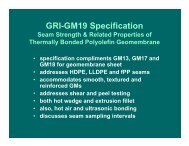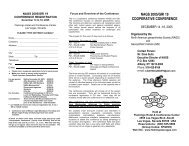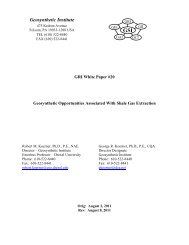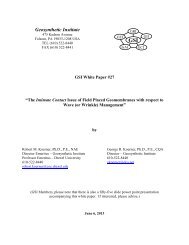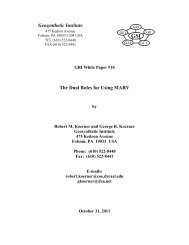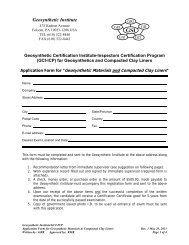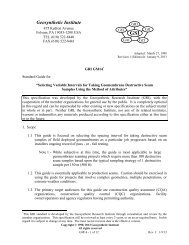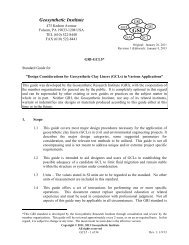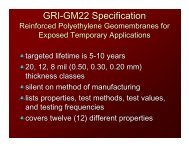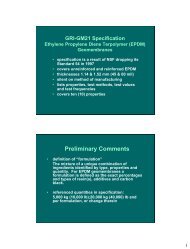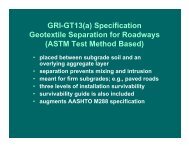December, 2012 - The Geosynthetic Institute
December, 2012 - The Geosynthetic Institute
December, 2012 - The Geosynthetic Institute
Create successful ePaper yourself
Turn your PDF publications into a flip-book with our unique Google optimized e-Paper software.
<strong>The</strong> GSI Newsletter/Report<br />
<strong>Geosynthetic</strong> <strong>Institute</strong><br />
<strong>Geosynthetic</strong><br />
Research <strong>Institute</strong><br />
(GRI)<br />
<strong>Geosynthetic</strong><br />
Education <strong>Institute</strong><br />
(GEI)<br />
<strong>Geosynthetic</strong><br />
<strong>Institute</strong><br />
(GSI)<br />
<strong>Geosynthetic</strong><br />
Information <strong>Institute</strong><br />
(GII)<br />
<strong>Geosynthetic</strong><br />
Accreditation <strong>Institute</strong><br />
(GAI)<br />
<strong>Geosynthetic</strong><br />
Certification <strong>Institute</strong><br />
(GCI)<br />
Vol. 26, No. 4 <strong>December</strong>, <strong>2012</strong><br />
This quarterly newsletter, now in its 26 th year, presents the activities of GSI and its related institutes to all who are interested. It is<br />
available on the institute’s home page at www.geosynthetic-institute.org. It also serves as a quarterly report to its member<br />
organizations. Details are available by contacting George R. Koerner or Marilyn Ashley at phone (610) 522-8440; fax (610) 522-<br />
8441 or e-mail at gkoerner@dca.net or mvashley@verizon.net.<br />
Happy Holidays and a Healthy<br />
and Prosperous New Year<br />
Activities of GSI’s Directors<br />
1. <strong>The</strong> Instructor’s Guide that accompanies and<br />
compliments the new 6 th Edition of Designing<br />
With <strong>Geosynthetic</strong>s is the hottest item we<br />
have…after all it’s free! It consists of a CD with<br />
1230 slides on it and it is not encrypted so one<br />
can add or subtract as desired. Just contact us<br />
and we will send it to you without any charge at<br />
all.<br />
2. <strong>The</strong> geosynthetics webinars (eight of them)<br />
being released through ASCE are quite popular<br />
with 10 to 45 companies accessing each of<br />
them. <strong>The</strong> complete set is offered twice a year.<br />
Go to www.asce.org/webinars for information.<br />
That said, ASCE offers many civil engineering<br />
topics but we believe ours are the only ones on<br />
geosynthetics.<br />
3. George is preparing to send proficiency samples<br />
to the GAI-LAP participants so expect them<br />
shortly before, or immediately after, the holidays.<br />
4. <strong>The</strong> series of four in-house courses did not draw<br />
well this Fall. A repeat will be offered in March,<br />
2013 and will assess the situation afterward.<br />
5. We are in the midst of our Board of Directors<br />
election cycle of 2013-2015 with John Workman<br />
of Waste Management, Inc. replacing Tony Eith<br />
(changed job) for the Owner/Operator group and<br />
Mark Wayne of Tensar replacing Boyd Ramsey<br />
of GSE for the Geotextile/Geogrid group. <strong>The</strong><br />
third position, which is At-Large is being balloted<br />
presently… more later.<br />
6. <strong>The</strong> present BOD is as follows, along with their<br />
respective term ending year’s.<br />
Term Ends 2013<br />
David Jaros - Corps of Engineers (Government<br />
Agencies)<br />
e-mail: dave.l.jaros@usace.army.mil<br />
Lili Cui – Chevron Phillips Co. (Resin/Additive)<br />
e-mail: cuil@cpchem.com<br />
Kent von Maubeuge - NAUE GmbH & Co. KG<br />
(International-1)<br />
e-mail: kvmaubeuge@naue.com<br />
IN THIS ISSUE<br />
Activities of the GSI Directors<br />
Overview of GRI Projects (Research)<br />
Progress within GII (Information)<br />
Progress within GEI (Education)<br />
Activities within GAI (Accreditation)<br />
Activities within GCI (Certification)<br />
<strong>The</strong> GSI Affiliated <strong>Institute</strong>s<br />
Items of Interest<br />
“On the Estimation of ‘Live Loads’ in<br />
<strong>Geosynthetic</strong> Design”<br />
Upcoming GSI Events<br />
GSI’s Member Organizations<br />
- 1 -
Term Ends 2014<br />
Mark Sieracke - Weaver Boos (Consultants and<br />
Testing Labs)<br />
e-mail: msieracke@weaverboos.com<br />
Tim Rafter - CETCO (Geomembranes and GCLs)<br />
email: tim.rafter@cetco.com<br />
Wayne Hsieh - NPUST and GSI-Taiwan<br />
(International-2)<br />
e-mail: cwh@mail.npust.edu.tw<br />
Term Ends 2015<br />
John Workman - Waste Management Inc.<br />
(Owners and Operators)<br />
e-mail: jworkman@wm.com<br />
Mark Wayne – Tensar Earth Technology<br />
(Geotextiles and Geogrids)<br />
e-mail: mwayne@tensarcorp.com<br />
Presently being balloted (At-Large)<br />
Overview of GRI Projects<br />
(Research)<br />
Each issue of our Newsletter/Report provides a brief<br />
glimpse and update of current GRI research projects.<br />
It will be noted that most projects are of a very long<br />
duration; one being up to 50-years! (In this regard<br />
short projects are given to design firms or testing<br />
laboratories that are GSI Members). Details and full<br />
briefings are available to member organizations at their<br />
request. Dr. Grace Hsuan, Associate Director of GRI<br />
can be contacted for additional information as can the<br />
other project managers listed in the following write-ups.<br />
Projects marked with an asterisk have been written<br />
up as either short “in-progress” papers or<br />
complete papers. Grace can be reached by email<br />
or phone at (610)<br />
522-8440.<br />
Important Notice: Use of GSI/GRI generated data<br />
and information is for member organization use<br />
assuming that the information is not taken out of the<br />
context of which it was developed. When used for<br />
formal publications such as proposals, regulatory<br />
permits, brochures and advertisements we would<br />
appreciate seeing a draft copy for possible comments.<br />
Thank you for your cooperation in this regard.<br />
1. In-Situ Temperature Monitoring of Liner and<br />
Cover Geomembranes in Dry and Wet<br />
Landfills* - George Koerner is measuring the insitu<br />
temperature behavior of liner and cover<br />
geomembranes and has installed 60±<br />
thermocouples for long term measurements in<br />
both wet and dry municipal solid waste landfills<br />
in Pennsylvania. <strong>The</strong> project has been extended<br />
into its 15 th -year and has resulted in an<br />
extremely authoritative set of real-life data.<br />
2. Bioreactor (aka, Wet) Landfill Behavior and<br />
Properties* - One of the landfill cells mentioned<br />
in Item #1 is at field capacity, hence it is a true<br />
anaerobic bioreactor. Dr. George Koerner is in<br />
charge of considerable monitoring at this cell<br />
which includes the following<br />
waste moisture content<br />
waste temperature<br />
leachate chemical analysis<br />
waste gas analysis<br />
perched leachate within the waste<br />
Data is being collected on a quarterly basis. <strong>The</strong><br />
timeline of the project calls for monitoring up to<br />
10 years. This activity has been extended to an<br />
adjacent landfill to see how reproducible the data<br />
is with a slightly different waste mass.<br />
3. Flow Behavior of Fully Degraded Waste* - A<br />
field project under sponsorship of GSI and<br />
Waste Management investigates the drainage of<br />
highly degraded MSW placed directly on<br />
leachate collection systems. <strong>The</strong> leachate<br />
collection materials consist of both natural soils<br />
and geosynthetic drains. <strong>The</strong> experimental<br />
setup has been dismantled and a presentation<br />
was given at the <strong>2012</strong> Global Waste Conference<br />
in Phoenix… a paper will follow.<br />
4. Field Exposed Lifetime of Geogrids Used at<br />
the Facing of Landfill Berms - <strong>The</strong> facing of<br />
mechanically stabilized earth landfill berms (and<br />
other walls and slopes as well) is often using a<br />
wrap-around configuration leaving the geogrid<br />
exposed to the atmosphere. A new project<br />
being conducted by George Koerner for Waste<br />
Management is presently investigating two<br />
different geogrid’s behavior over time. A 50-year<br />
time frame is envisioned. <strong>The</strong> long-term behavior<br />
will eventually be compared to UV laboratory<br />
exposed data as noted in Item #7 below.<br />
5. Field Behavior of fPP and fPP-R<br />
Geomembranes - We continue to receive and<br />
evaluate field samples of flexible polypropylene<br />
geomembranes (mainly scrim reinforced). <strong>The</strong>y<br />
are regularly added to our database in this<br />
regard. <strong>The</strong> most recent was for potable water<br />
storage and had a service lifetime of 10-years.<br />
Using our correlation factor of 1200 light hours in<br />
D7238 at 70°C being equivalent to one-year in a<br />
hot climate, this is equivalent to a laboratory<br />
exposure in the weathering device of 12,000<br />
light hours. Our GRI-GM18 specification calls<br />
for 20,000 light hours for an acceptable<br />
formulation which is essentially a factor-of-safety<br />
of 1.7.<br />
6. Laboratory Exposed Lifetime of<br />
Geomembranes* - GSI is using three UVfluorescent<br />
devices to estimate the projected<br />
exposed lifetime of many different types of<br />
geomembranes. Presently being incubated are<br />
HDPE, LLDPE, fPP, PVC (N.A.), and EPDM.<br />
Exposure times of 50,000 light hours are now<br />
- 2 -
ealized at 70°C and a replicate set of samples<br />
are being incubated at 60°C. Some will take at<br />
least 70,000 light hours ( ten years). <strong>The</strong> third<br />
sequence at 80°C was started on 1/1/2010.<br />
Ongoing data is being reported to manufacturers<br />
and resin producers. GRI Report #42 is<br />
available on the 70°C data using a correlation<br />
coefficient to estimate field lifetime of the various<br />
geomembranes.<br />
7. Laboratory Exposed Lifetime of PVC<br />
(European) Geomembranes - Of late, we have<br />
been attempting to distinguish between PVC<br />
geomembranes manufactured in North America<br />
versus Europe. Of course, the difference is in<br />
the type of plasticizers and other additives used<br />
in the formulations. In this regard we have been<br />
evaluating various European formulations for<br />
four years using three dedicated UV-fluorescent<br />
devices and the results are very impressive.<br />
<strong>The</strong> study is being conducted for CARPI Tech, a<br />
GSI member organization.<br />
8. Laboratory Exposed Lifetime of Geogrids -<br />
<strong>The</strong> UV-fluorescent exposure of two different<br />
polypropylene biaxial geogrids which are used at<br />
the exposed faces of welded wire mesh MSE<br />
structures is ongoing. <strong>The</strong> various geogrids are<br />
now up to 40,000 light hours and data is being<br />
generated and sent to the respective<br />
manufacturers; Tensar and TenCate. Replicate<br />
samples are now being incubated at 60°C for<br />
eventual use in Arrhenius Modeling and lifetime<br />
prediction. <strong>The</strong> last set at 80°C has just begun<br />
incubation.<br />
9. Laboratory Exposed Lifetime of TRM Fibers -<br />
We are also using UV-fluorescent exposure of<br />
four different turf reinforcement mat fibers to<br />
assess their lifetime capabilities. <strong>The</strong>y are<br />
presently being incubated at 60°C, 70°C and<br />
80°C. Communication between the<br />
manufacturer Propex is ongoing.<br />
10. Laboratory Exposed Lifetime of Geotextiles -<br />
We have just completed a UV study on a heatbonded<br />
nonwoven PP geotextile used for three<br />
dimensional cell structures which are exposed to<br />
the atmosphere. <strong>The</strong> results for the particular<br />
geotextile and its specific formulation at 20°C<br />
(68°F) average field temperature are 4.9 years<br />
for halflife of breaking strength and 4.1 years for<br />
halflife of breaking elongation.<br />
11. Laboratory Exposed Lifetime of<br />
Geomembrane Tapes - <strong>The</strong>re are several<br />
adhesive sided geomembrane tapes used to<br />
repair exposed geomembranes. Two different<br />
types are being evaluated in our QUV exposure<br />
devices.<br />
12. Retaining Wall Failure Evaluations* - We<br />
presently have GRI Reports 38, 39, and 40<br />
addressing mechanical stabilized earth (MSE)<br />
walls using geosynthetic reinforcement which<br />
document 82-failures. Our data base has now<br />
increased to 171 failures and continues to grow!<br />
- 3 -<br />
<strong>The</strong> failures are either excessive deformation or<br />
collapses. We have presented one-day courses<br />
on this topic along with inspector training and<br />
development insofar as a field inspectors<br />
certification program; see the certification section<br />
of this Newsletter/Report. We have just recently<br />
presented the findings at two geotechnical<br />
conferences; one in Williamsburg and the other<br />
in Hershey. A paper on the first 141 failures is<br />
available.<br />
13. pH Between Masonry Block Wall Units* -<br />
George Koerner has been measuring the pH<br />
between three types of masonry blocks for over<br />
six years to monitor the values. Concern here is<br />
over PET geogrids which are known to be<br />
sensitive to high alkalinity environments.<br />
Indeed, the values started high, but over time<br />
are now down to eight and lower. George<br />
Koerner has a paper in this regard.<br />
14. Landfill Failure Analysis - Since our originally<br />
reported paper on ten landfill failures in a 2000<br />
publication, we have accumulated ten more. All<br />
20-failures have been analyzed by Dr. Connie<br />
Wong using the ReSSA Code and are now<br />
available to members and associate members<br />
as GRI Report #41.<br />
15. Puncture Behavior of Nontraditional<br />
Protection GSs - A member organization asked<br />
about the protection afforded to a geomembrane<br />
by geonet composites and GCL’s. As a result,<br />
we have just concluded a laboratory study using<br />
three different probes against various GMs<br />
protected by geotextiles, GCs and GCLs. <strong>The</strong><br />
resulting paper has been published by ASTM’s<br />
Journal of Geotechnical Testing… it’s available.<br />
16. Slow Pressurization of HDPE Geomembranes<br />
in Axi-Symmetric Testing – <strong>The</strong> ASTM D5716<br />
method of testing geomembranes in a 3-D axisymmetric<br />
mode uses a pressure rate of 6.9<br />
kPa/min (1.0 psi/min). While such a rate is<br />
reasonable for most geomembrane types, it is<br />
questionable for HDPE which is semi-crystalline<br />
and cannot stress relax. To investigate slower<br />
rates Bob Koerner is performing a new project<br />
with rates as low as 6.9 kPa/month (1.0<br />
psi/month)! Initial data is available.<br />
17. CaCO 3 in Bentonites Contained Within GCL’s<br />
- It is possible that the amount of calcium<br />
carbonate contained within the bentonite of<br />
different GCL’s is indicative of their hydraulic<br />
performance. George Koerner has evaluated<br />
15-bentonites and has a paper in progress.<br />
18. Generic Specifications - A major effort is<br />
ongoing with respect to the development and<br />
maintenance of generic geosynthetic<br />
specifications. <strong>The</strong> current status of these<br />
specifications is as follows:<br />
Completed, Available and Regularly Updated<br />
GM13 – HDPE Geomembranes<br />
GM17 – LLDPE Geomembranes
GM18 – fPP and fPP-R Geomembranes<br />
GM21 – EPDM and EPDM-R Geomembranes<br />
GM22 – Exposed Temporary Covers<br />
GM25 – LLDPE-R Geomembranes<br />
GM19 – Geomembrane Seams<br />
GT10 – Geotextile Tubes<br />
GT12 – Geotextile Cushions<br />
GT13 – Geotextile Separators<br />
GCL3 – <strong>Geosynthetic</strong> Clay Liners<br />
Working Within Focus Group<br />
GTXX – Turf Reinforcement Mats (tabled)<br />
GCXX – Geocells<br />
Delayed or Off in the Distance<br />
GGXX – Bidirectional Geogrids<br />
GGXX – Unidirectional Geogrids<br />
GNXX – Geonet Drainage Composites<br />
GCXX – Other Drainage Geocomposites<br />
GSXX – High Strength Reinforcement Geotextiles<br />
<strong>The</strong> complete set of specifications are available<br />
to everyone (members and nonmembers) on the<br />
open section of our Home Page. Please<br />
download and use them accordingly. Also note<br />
that this is where the latest modification will<br />
always be available. <strong>The</strong>re is a brief tutorial<br />
accompanying each specification. <strong>The</strong>y will be<br />
updated shortly. Copies of the above listed draft<br />
specification tables are also available to<br />
members and associate members.<br />
19. Other GRI Standards - <strong>The</strong>re are several GRI<br />
Standards in various forms of preparation.<br />
<strong>The</strong>se include the following:<br />
Guide for constructing test pads<br />
guide for lifetime prediction using TTS and<br />
Arrhenius modeling<br />
Test method for average geomembrane<br />
thickness<br />
guide for geocell seaming efficiency<br />
A group of test methods being prepared for<br />
both Milliken and <strong>The</strong>rmaGreen Companies<br />
for their respective new products.<br />
Progress within GII<br />
(Information)<br />
Our GSI Home Page (which has a revised opening<br />
format) is accessed as follows:<br />
<br />
It has been completely revised and is being maintained<br />
through the fine efforts of Marilyn Ashley. Everyone<br />
(members and nonmembers) can access the open<br />
part, which has the following menu:<br />
Introduction to GSI<br />
Prospectus<br />
Associate Membership (Agencies)<br />
Members by Focus Groups<br />
GSI Publications<br />
GRI Specs, Guides, White Papers<br />
Laboratory Accreditation<br />
Product Certification<br />
Newsletter/Reports<br />
Internet Courses<br />
GSI Members Links<br />
GSI Member Meetings<br />
Courses at GSI<br />
Insp. Cert. Programs<br />
To go further one needs a members-only password.<br />
Your contact person (see the last section of this<br />
Newsletter/Report if you do not know who it is) must<br />
get a password from Marilyn Ashley. Marilyn can be<br />
reached by e-mail at mvashley@verizon.net. When you<br />
get into this section, the following information is<br />
available. This includes:<br />
GRI Test Methods<br />
GRI Reports<br />
GRI Technical Papers<br />
(Citations)<br />
Notes of GSI Meetings<br />
Links to the GSs World<br />
Keyword Search for Literature<br />
Example Problems<br />
Frequently Asked Questions<br />
(FAQs)<br />
<strong>The</strong> Keywords Section contains about 30,000 citations<br />
which is the majority of the geosynthetics literature<br />
published in English. It’s quite easy to use provided<br />
that you have a specific topic, or area, in mind. This is<br />
the section of the website that we (and others we are<br />
told) use the most in our daily activities.<br />
In addition to the information provided in our home<br />
page as just mentioned, Jamie Koerner (Special<br />
Projects Coordinator) is performing various surveys of<br />
pertinent topics in geosynthetics.<br />
Most of these have been turned into GRI White<br />
Papers; the following being the most recent.<br />
#20 - GS Opportunities with Shale Gas Extraction<br />
#21 - State Regulatory Departments Involved in Shale<br />
Gas Permitting<br />
#22 - Selected GS Opportunities with Energy<br />
Production and Transmission<br />
#23 - EPA Agencies Regarding Landfill Berms<br />
#24 - Reduction Factor for Holes in GS Reinforcement<br />
#25 - <strong>The</strong> Separation-in-Plane (SIP) Mode of Failure<br />
When Testing GM Seams<br />
#26 - Need for Justification of Quality Management<br />
Systems for Successful GS Performance<br />
Jamie’s most recent survey is a retrospective review of<br />
the 136 faculty which participated in the Educate-the-<br />
Educators week-long courses at Auburn University<br />
from 1994-1998. Do ask for a copy if interested.<br />
Progress within GEI<br />
(Education)<br />
Free CD<br />
We sent a broadcast e-mail to everyone stating that<br />
many power point presentations were available and<br />
- 4 -
would be sent upon request. Many persons replied<br />
asking for all of them. <strong>The</strong>refore, we put all 63<br />
presentations on a CD which was sent to all GSI<br />
contact persons. That said, we have many copies still<br />
available so do ask and we will mail it to you<br />
immediately. Topic areas are all types of<br />
geosynthetics, plus walls/slopes, landfills,<br />
specifications, and miscellaneous.<br />
6 th Edition of Designing With <strong>Geosynthetic</strong>s<br />
<strong>The</strong> 6 th Edition of Designing With <strong>Geosynthetic</strong>s<br />
continues to sell well in all three of its formats;<br />
hardback, softback and e-book… the latter is really<br />
cheap!<br />
<strong>The</strong> two volume set can be purchased through GSI,<br />
Xlibris, Amazon and Barnes and Noble. A special link<br />
in available on the cover page of our website.<br />
Our most recent activity in this regard is to develop a<br />
power point presentation for the entire 914-page book.<br />
This is what it looks like and it does indeed contain<br />
1230 nonencrypted ppt slides.<br />
<br />
<br />
<br />
#40 – On the Prevention of Failures of<br />
<strong>Geosynthetic</strong> Reinforced MSE Walls and<br />
Recommendations Going Forward<br />
#41 – Analysis and Critique of Twenty Large<br />
Solid Waste Landfill Failures<br />
#42 – Lifetime Prediction of Laboratory UV<br />
Exposed Geomembranes Based on a<br />
Correlation Factor (due January 2, <strong>2012</strong>)<br />
Courses<br />
We have just scheduled the following set of courses:<br />
#1 March 13, 2013<br />
MSE Wall Failures and <strong>The</strong>ir Remediation<br />
#2 March 14, 2013<br />
Construction Inspection of MSE Walls, Berms and<br />
Slopes<br />
(Optional Exam Follows)<br />
#3 March 20, 2013<br />
Design and Testing of <strong>Geosynthetic</strong>s in Waste<br />
Containment Systems<br />
#4 March 21, 2013<br />
QA/QC of <strong>Geosynthetic</strong>s in Waste Containment<br />
Systems<br />
(Optional Exam Follows)<br />
Each course carriers with it 8 PDH’s. All are held at<br />
GSI so demonstrations by George enliven and<br />
illustrate the respective lectures. GSI is approximately<br />
4.5 miles from Philadelphia International Airport.<br />
Course Registration and Fee:<br />
$350/person for each one-day course (up to one<br />
month prior to course)<br />
$400/person thereafter<br />
$250/person – GSI Members<br />
Contact: Marilyn Ashley (mvashley@verizon.net)<br />
Call or e-mail if you want a copy. It is free to all, but<br />
we need your postal address.<br />
GRI Reports<br />
To date, we have 42 GRI Reports available to<br />
members and associate members. <strong>The</strong>se reports vary<br />
in length from 30 to 200 pages and beginning with<br />
Report #25 they are on the password protected section<br />
of our home page. Prior to that date only the abstract<br />
is available online. All of them, however, are available<br />
in hard copy. <strong>The</strong> most recent reports are as follows:<br />
#38 – A Data Base and Analysis of<br />
<strong>Geosynthetic</strong> Reinforced Wall Failures<br />
#39 – Methods of Stabilizing Excessively<br />
Deformed MSE Walls<br />
GSI Fellowships<br />
As in the past, GSI has been awarding graduate<br />
fellowships for students performing geosynthetics<br />
research. <strong>The</strong>re were nine new proposals this<br />
academic year. <strong>The</strong>se proposals were then reviewed<br />
by the GSI Board of Directors along with Bob and<br />
George Koerner.<br />
<strong>The</strong> presently established criteria are as follows:<br />
Students must be working on a geosynthetics<br />
topic which furthers the technology in a<br />
proactive manner.<br />
Students must have completed their candidacy<br />
requirements leading to a doctoral degree.<br />
(Comment, we hope that some of them will “go<br />
academic” and teach and/or research<br />
geosynthetics in their immediate future)<br />
Students must be recommended by their<br />
advisor or department head.<br />
- 5 -
<strong>The</strong> fellowships can be renewed for a total of<br />
three-years depending upon acceptable<br />
annual reports.<br />
Funding for each student is $10,000 the first<br />
year and $5000 for the second and third years.<br />
<strong>The</strong> following table identifies the successful recipients,<br />
their university, advisor and topic. We congratulate the<br />
students and wish them success in their endeavors. If<br />
any readers wish to add congratulations or to find<br />
greater detail as to specific projects and students<br />
please contact us accordingly.<br />
GSI Fellowship Status for <strong>2012</strong>-‘13 Academic Year<br />
Class 4 (a) – 2 nd Year Funding at $5,000 per student<br />
No. Name University Advisor Topic<br />
3-11 Felix<br />
Jacobs<br />
Martin<br />
Ziegler<br />
4-11 Mahmound<br />
Khachan<br />
RWTU-<br />
Aachen,<br />
Germany<br />
Syracuse<br />
University<br />
Shobha<br />
Bhatia<br />
Geogrid<br />
Reinforced<br />
Soil in Biaxial<br />
Compression<br />
Tests<br />
Dewatering<br />
Performance<br />
of Geotextile<br />
Tubes<br />
Class 5 (a) – 1 st Year Funding at $10,000 per student<br />
No. Name University Advisor Topic<br />
1-12 Chuangi<br />
Wang<br />
2-12 Xunchang<br />
Fei<br />
3-12 Jitendra<br />
K. Thakur<br />
University<br />
of<br />
Memphis<br />
University<br />
of<br />
Michigan<br />
Univeristy<br />
of Kansas<br />
David<br />
Arellano<br />
Dimitrois<br />
Zekkos<br />
Jie Han<br />
Activities within GAI<br />
(Accreditation)<br />
Properties of<br />
Recycled<br />
Expanded<br />
Polystyrene<br />
Biodegradation<br />
of Geotextiles<br />
Recycled<br />
Asphalt Used<br />
in Geocells<br />
<strong>The</strong> <strong>Geosynthetic</strong> Accreditation <strong>Institute</strong>’s (GAI)<br />
current mission is focused on a Laboratory<br />
Accreditation Program (LAP) for geosynthetic test<br />
methods. George Koerner is in charge of the program.<br />
<strong>The</strong> GAI-LAP was developed for accrediting<br />
geosynthetic testing laboratories on a test-by-test<br />
basis. GAI-LAP suggests that laboratories use ISO<br />
17025 as their quality system model. In addition, the<br />
program uses the GSI lab as the reference test lab and<br />
operates as an ISO 17011 enterprise. In short, this<br />
means that the GSI lab does not conduct outside<br />
commercial testing.<br />
It should also be made clear that GAI-LAP does not<br />
profess to offer ISO certification, nor does it “certify”<br />
laboratory results. GAI-LAP provides accreditation to<br />
laboratories showing compliance with equipment and<br />
- 6 -<br />
documentation for specific standard ASTM, ISO or GRI<br />
test methods. In addition, GAI-LAP verifies that an<br />
effective quality system exists at accredited<br />
laboratories by way of proficiency testing.<br />
<strong>The</strong>re have been significant additions to the number of<br />
GAI-LAP tests. Presently, there are 230 GAI-LAP test<br />
methods available for accreditation. Please consult our<br />
home page for a current listing.<br />
As of <strong>December</strong>, <strong>2012</strong>, the following laboratories are<br />
accredited by the GAI-LAP for the number of test<br />
methods listed in parenthesis. Contact personnel,<br />
telephone numbers and e-mails are also listed.<br />
1 A - TRI/Environmental Inc. (118 tests)<br />
Sam Allen -- (512) 263-2101<br />
Sallen@tri-env.com<br />
3 A - Golder Associates (45 tests)<br />
David Alexander -- (770) 492-8280<br />
dalexander@golder.com<br />
4 C - <strong>Geosynthetic</strong> <strong>Institute</strong> (116 tests)<br />
George Koerner -- (610) 522-8440<br />
gkoerner@dca.net<br />
8 B - Propex, Ringgold (19 tests)<br />
Todd Nichols -- (800) 258-3121<br />
todd.nichols@propexinc.com<br />
9 B - Lumite (10 tests)<br />
Rebecca Kurek -- (770) 869-1700<br />
rpage@lumiteco.com<br />
13 A - Precision Laboratories, CA (95 tests)<br />
Cora Queja -- (714) 520-9631<br />
cqueja@precisionlabs.net<br />
14 A - Geotechnics (57 tests)<br />
J. P. Kline -- (412) 823-7600<br />
JPkline@geotechnics.net<br />
20 A - GeoTesting Express, MA (46 tests)<br />
Gary Torosian -- (978) 635-0424<br />
gtt@geotesting.com<br />
22 B - CETCO Hoffman Estates (13 tests)<br />
Jim Olsta -- (847) 392-5800<br />
jim.olsta@cetco.com<br />
23 B - CETCO Cartersville (10 tests)<br />
Chris Cunningham -- (706) 337-5316<br />
christopher.cunningham@cetco.com<br />
24 B - CETCO Lovell (10 tests)<br />
Roger Wilkerson -- (307) 548-6521<br />
roger.wilkerson@cetco.com<br />
25 B - Ten Cate, Pendergrass (11 tests)<br />
Beth Wilbanks -- (706) 693-2226<br />
b.wilbanks@tencate.com<br />
26 B - Agru America Inc. (17 tests)<br />
Grant Palmer -- (843) 546-0600<br />
gp@agruamerica.com<br />
29 e - FITI Testing and Research <strong>Institute</strong> (86 tests)<br />
Hong-Kwan Kim -- 82-2-3299-8071<br />
hoganKim@fiti.re.kr<br />
31 D - NYS Dept. of Transportation (9 tests)<br />
John Remmers -- (518) 457-4104<br />
Jremmers@dot.state.ny.us<br />
32 A - Geo-Logic Inc. (6 tests)<br />
Ken Criley -- (530) 272-2448<br />
criley@geologic.com<br />
34 B - GSE Richey Road (34 tests)<br />
Jane Allen -- (281) 230-6726<br />
Jallen@gseworld.com<br />
37 B - GSE Chile (21 tests)<br />
Mauricio Ossa -- 56-2 6010153<br />
Mossa@gseworld.com<br />
38 C - Sageos/CTT Group (91 tests)<br />
Eric Blond -- (450) 771-4608<br />
eblond@groupecttgroup.com
40 B - GSE Lining Technology Inc. (17 tests)<br />
Vicki Parrott -- (843) 382-4603<br />
Vparrott@gseworld.com<br />
41 A - SGI Testing Service, LLC (19 tests)<br />
Zehong Yuan -- (770) 931-8222<br />
ZYuan@interactionspecialists.com<br />
42 C - NPUST (GSI-Taiwan) (69 tests)<br />
Chiwan Wayne Hsieh -- 011-886-8-7740468<br />
CWH@mail.npust.edu.tw<br />
43 A - Ardaman & Associates (18 tests)<br />
George DeStafano -- (407) 855-3860<br />
gdestafano@ardaman.com<br />
44 B - Fiber Web, Inc. (9 tests)<br />
Adam Lyons -- (615) 847-7575<br />
adam.lyons@fiberweb.com<br />
45 B - Ten Cate Malaysia SDN Bhd. (23 tests)<br />
C. P. Ng -- (603) 519 28568<br />
cp.ng@tencate.com<br />
46 B - TAG Environmental Inc. (13 tests)<br />
Colin Murphy -- (705) 725-1938<br />
colin_murphy@tagenv.com<br />
47 B - Syntec LLC (9 tests)<br />
Jeffrey Hicks – (410) 327-1070<br />
jhicks@synteccorp.com<br />
49 B - Engepol Geossinteticos (19 tests)<br />
Carolina Polomino -- (55) 11-4166 3001<br />
carolina@engepol.com<br />
50 B - ADS, Inc. Hamilton (7 tests)<br />
Terry McElfresh -- (513) 896-2065<br />
mcelfresh@ads-pipe.com<br />
51 B - Solmax International Inc. (20 tests)<br />
Simon Gilbert St. Pierre -- (450) 929-1234<br />
simonGSP@solmax.com<br />
53 B - Polytex Inquique (13 tests)<br />
Cristian Valdebenito -- 011 56 57 42 90 00<br />
cvaldebenito@polytex.cl<br />
54 B - ADS, Inc. Finley (9 tests)<br />
David Gonso -- (419) 424-8377<br />
davegonso@ads-pipe.com<br />
55 B - Atarfil Geomembranes (20 tests)<br />
Iganacio Garcia Arroyo -- 34 958 439 278<br />
ngarcia@atarfil.com<br />
56 B - Polytex Santiago (11 tests)<br />
Jamie Morales -- 56-2-627-2054<br />
Jmorales@polytex.cl<br />
57 B - Ten Cate Cornelia (15 tests)<br />
Melissa Medlin -- (706) 778-9794<br />
m.medlin@tencate.com<br />
58 B - Propex Nashville (9 tests)<br />
Tim Smith -- (229) 686-5511<br />
Timothy.Stark@propexglobal.com<br />
59 B - Firestone (9 Tests)<br />
Janie Simpson -- (864) 439-5641<br />
SimpsonJanie@firestone.com<br />
60 B - Polytex Lima (11 tests)<br />
Elias Jurufe -- 51 16169393<br />
Ejarufe@polytex.cl<br />
61 B - Raven Industries (17 tests)<br />
Justin Norberg -- (605) 335-0288<br />
Justin.Norberg@ravenind.com<br />
62 B - Solmax International Asia (14 tests)<br />
Marie Andre Fortin – (450) 929-1234<br />
mafortin@solmax.com<br />
63 A - TRI Environmental, Inc.; DDRF (4 tests)<br />
Joel Sprague -- (864) 242-2220<br />
JSprague@tri-env.com<br />
64 B - Agru America (NV) (14 tests)<br />
Chris Adams -- (775) 835-8282<br />
ca@agruamerica.com<br />
65 C - Bombay Textile Rsearch Assoc. (BTRA) (24 tests)<br />
Riyaz Shaikh<br />
(0) 022-25003551<br />
btra@vsnl.com<br />
66 B - Rowad International <strong>Geosynthetic</strong>s Co. Ltd (14 tests)<br />
Asad Ullah Khan -- +966-3-812-1360<br />
usad@rowadplastic.com<br />
- 7 -<br />
67 A - MicroBac Hauser Division (8 tests)<br />
Steve Ferry – (720) 406-4806<br />
steve.ferry@microbac.com<br />
68 B - Glen Raven Technical Fabrics LLC (3 tests)<br />
Edmund Gant -- (336) 229-5576<br />
egant@glenraven.com<br />
69 B - GSE Lining Technology Co. Ltd. (12 tests)<br />
Siriporn Chayaporenlert – 6638-636638<br />
siriporna@gseworld.com<br />
70 A - RSA Geo Lab LLC (48 tests)<br />
Raza Ahmed – (908) 964-0786<br />
geolab13@yahoo.com<br />
71 B - Plasticos Agricolas y Geomembranas S.A.C. (14 tests)<br />
Jhoana Carolina Diaz Martinez – 6370 (20 110811)<br />
calidad@pqaperu.com<br />
A Third Party Independent<br />
B Manufacturers QC<br />
C <strong>Institute</strong><br />
D Government<br />
If you desire more information on the GAI-LAP, its test<br />
methods, and the associated laboratories, a directory<br />
is published annually in <strong>December</strong> of each year. It is<br />
available on GSI’s home page at<br />
http://www.geosynthetic-institute.org (Accreditation).<br />
We thought is appropriate to mention that GRI has<br />
been developing Test Methods, Guides and Practices<br />
since its inception in the early 1980’s. GRI started<br />
writing specifications in 1993 when NSF decided to<br />
withdraw Standard 54. At present we have the<br />
following list of GRI Standards; Test Methods, Guides,<br />
Practices and Specifications. As you can see many of<br />
these documents have morphed into ASTM<br />
documents. This transition can be fast or slow<br />
depending on need or finding the right task group<br />
chairmen as its champion.<br />
Geotextile (GT) Related<br />
GT1 Geotextile Filter Performance via Long Term Flow (LTF)<br />
Tests<br />
GT2 Biological Clogging of Geotextile or Soil/Geotextile<br />
Filters (1987) (see ASTM D1987)<br />
GT3 Deterioration of Geotextiles from Outdoor Exposure<br />
(see ASTM D5970)<br />
GT4 Geotextile Permittivity-Under-Load (1991)<br />
(discontinued, see ASTM D5493)<br />
GT5 Tension Creep Testing of Geotextiles (April 6, 1992)<br />
(see ASTM D5262)<br />
GT6 Geotextile Pullout (see ASTM D6706)<br />
GT7 Determination of Long-Term Design Strength of<br />
Geotextiles<br />
GT8 Fine Fraction Filtration Using Geotextile Filters<br />
GT9 Grip Types for Use in Wide Width Testing of Geotextiles<br />
and Geogrids<br />
GT10 Test Methods, Properties and Frequencies for High<br />
Strength Geotextile Tubes used as Coastal and Riverine<br />
Structures<br />
GT11 Installation of Geotextile Tubes used as Coastal and<br />
Riverine Structures<br />
GT12(a) Test Methods and Properties for Nonwoven<br />
Geotextiles Used as Protection (or Cushioning) Materials -<br />
ASTM Version<br />
GT12(b) Test Methods and Properties for Nonwoven<br />
Geotextiles Used as Protection (or Cushioning) Materials -<br />
ISO Version<br />
GT13(a) Test Methods and Properties for Geotextiles Used<br />
as Separation Between Subgrade Soil and Aggregate -<br />
ASTM Version
GT13(b) Test Methods and Properties for Geotextiles Used<br />
as Separation Between Subgrade Soil and Aggregate - ISO<br />
Version<br />
GT14 <strong>The</strong> Hanging Bag Test for Field Assessment of Fabrics<br />
Used for Geotextile Bags, Containers and Tubes<br />
GT15 <strong>The</strong> Pillow Test For Field Assessment of<br />
Fabrics/Additives for Geotextile Bags, Containers and Tubes<br />
Geogrid (GG) Related<br />
GG1 Geogrid Rib Tensile Strength (see ASTM D6637)<br />
GG2 Geogrid Junction Strength<br />
GG3(a) Tension Creep Testing of Stiff Geogrids (Jan. 30,<br />
1991) (see ASTM D5262)<br />
GG3(b) Tension Creep Testing of Flexible Geogrids (Jan. 30,<br />
1991) (see ASTM D5262)<br />
GG4(a) Determination of the Long-Term Design Strength of<br />
Stiff Geogrids<br />
GG4(b) Determination of the Long-Term Design Strength of<br />
Flexible Geogrids<br />
GG5 Test Method for Geogrid Pullout (see ASTM D6706)<br />
GG6 Grip Types for Use in Width Width Testing of<br />
Geotextiles and Geogrids<br />
GG7 Carboxyl End Group Content of PET Yarns<br />
GG8 Determination of the Number Average Molecular<br />
Weight of PET Yarns Based on a Relative Viscosity Value<br />
GG9 Torsional Behavior of Bidirectional Geogrids When<br />
Subjected to In-Plane Rotation<br />
GG10 Determination of the Flexural Rigidity of Geogrids<br />
Geonet (GN) Related<br />
GN1 Compression Behavior of Geonets (see ASTM D6364)<br />
GN2 Joining and Attaching Geonets and Drainage<br />
Geocomposites<br />
Geomembrane (GM) Related<br />
GM1 Seam Evaluation by Ultrasonic Shadow Method<br />
GM2 Embedment Depth for Anchorage Mobilization<br />
GM3 Large Scale Hydrostatic Puncture Test (see ASTM<br />
D5514)<br />
GM4 Three Dimensional Geomembrane Tension Test (see<br />
ASTM D5617)<br />
GM5(a) Notched Constant Tensile Load (NCTL) Test for<br />
Polyolefin Resins or Geomembranes (1992) (see ASTM<br />
D5397)<br />
GM5(b) Single Point NCTL Test for Polyolefin Resin or<br />
Geomembranes (see ASTM D5397 Appendix)<br />
GM5(c) Seam Constant Tensile Load (SCTL) Test for<br />
Polyolefin Geomembrane Seams<br />
GM6 Pressurized Air Channel Test for Dual Seamed<br />
Geomembranes<br />
GM7 Accelerated Curing of Geomembrane Test Strip Seams<br />
Made by Chemical Fusion Methods<br />
GM8 Measurement of the Core Thickness of Textured<br />
Geomembranes (see ASTM D5994)<br />
GM9 Cold Weather Seaming of Geomembranes<br />
GM10 <strong>The</strong> Stress Crack Resistance of HDPE Geomembrane<br />
Sheet<br />
GM11 Accelerated Weathering of Geomembranes Using a<br />
Fluorescent UVA Device (see ASTM D7238)<br />
GM12 Asperity Measurement of Textured Geomembranes<br />
using a Depth Gage (See ASTM D7466)<br />
GM13 Test Methods, Properties and Testing Frequency for<br />
High Density Polyethylene (HDPE) Smooth and Textured<br />
Geomembranes<br />
GM14 Selecting Variable Intervals for Taking Geomembrane<br />
Destructive Seam Samples Using the Method of Attributes<br />
GM15 Determination of Ply Adhesion of Reinforced<br />
Geomembranes (see ASTM D6636)<br />
GM16 Observation of Surface Cracking of Geomembranes<br />
GM17 Test Methods, Properties and Testing Frequency for<br />
Linear Low Density Polyethylene (LLDPE) Smooth and<br />
Textured Geomembranes<br />
GM18 Test Methods, Properties and Testing Frequency for<br />
Flexible Polypropylene (fPP and fPP-R) Nonreinforced and<br />
Reinforced Geomembranes<br />
GM19 Seam Strength and Related Properties of <strong>The</strong>rmally<br />
Bonded Polyolefin Geomembranes<br />
GM20 Selecting Variable Intervals for Taking Geomembrane<br />
Destructive Seam Samples Using Control Charts<br />
GM21 Test Methods, Properties and Testing Frequency for<br />
Ethylene Propylene Diene Terpolymer (EPDM)<br />
Nonreinforced and Scrim Reinforced Geomembrane<br />
GM22 Test Methods, Required Properties and Testing<br />
Frequencies for Scrim Reinforced Polyethylene<br />
Geomembranes Used in Exposed Temporary Applications<br />
GM23 Laboratory and/or Field Observation of Surface<br />
Chalking of Flexible Polypropylene Geomembranes<br />
GM24 Incubation and Subsequent Evaluation of Single 180°<br />
and Double 180° Folding of Geomembranes<br />
Geomembrane (GM) Related (cont.)<br />
GM25 Test Methods, Test Properties and Testing Frequency<br />
for Reinforced Linear Low Density Polyethylene (LLDPE-R)<br />
Geomembranes<br />
GM26 Smoke Testing of Field Fabricated Geomembranes<br />
<strong>Geosynthetic</strong> Clay Liner (GCL) Related<br />
GCL1 Swell Measurement of the Clay Component of GCL's<br />
(see ASTM D5890)<br />
GCL2 Permeability of <strong>Geosynthetic</strong> Clay Liners (GCLs) (see<br />
ASTM D5887 and ASTM D6766)<br />
GCL3 Test Methods, Required Properties, and Testing<br />
Frequencies of <strong>Geosynthetic</strong> Clay Liners (GCLs)<br />
GCL4 Gripping of Reinforced GCLs to End Platens During<br />
Direct (Interface) Shear Testing<br />
Geocomposite (GC) Related<br />
GC1 Soil-Filter Core Combined Flow Test<br />
GC2 Strip Drain Flow Rate Under Load<br />
GC3 Strip Drain Kinking Efficiency<br />
GC4 Compression Behavior of Prefabricated Edge Drains<br />
and Sheet Drains<br />
GC5 Erosion Control Systems to Protect Against Soil<br />
Detachment by Rainfall Impact and Overload Flow Transport<br />
GC6 Erosion Control Systems for High Velocity Flows in<br />
Channels<br />
GC7 Determination of Adhesion and Bond Strength of<br />
Geocomposites (see ASTM D7005)<br />
GC8 Determination of the Allowable Flow Rate of a Drainage<br />
Geocomposite<br />
GC9 Mechanical Deformation Behavior of <strong>Geosynthetic</strong><br />
Aggregate Drainage Systems<br />
GC10 Hydraulic Behavior of <strong>Geosynthetic</strong> Aggregate<br />
Drainage Systems<br />
GC11 Retrieval of Geocells from the Field to Evaluate<br />
Installation Distortion and/or Damage<br />
GC12 Mechanical Deformation Behavior of Geocell Systems<br />
GC13 Joining and Attaching Geonets and Drainage<br />
Geocomposites<br />
<strong>Geosynthetic</strong> (GS) Related (i.e., Multipurpose)<br />
GS1 CBR Puncture Strength (see ASTM D6241)<br />
GS2 Rupture Strength of <strong>Geosynthetic</strong>s by Pendulum Impact<br />
GS3 Selecting In-Situ Monitoring Methods and Devices for<br />
the Evaluation of <strong>Geosynthetic</strong> Performance<br />
GS4 Time Dependent (Creep) Deformation Under Normal<br />
Pressure<br />
GS5 Impregnation of <strong>Geosynthetic</strong>s Under Load<br />
GS6 Interface Friction Determination by Direct Shear Testing<br />
(Jan. 30, 1991) (see ASTM D5321)<br />
GS7 Determining the Index Friction Properties of<br />
- 8 -
<strong>Geosynthetic</strong>s<br />
GS8 Determining the Connection Strength of Mechanically<br />
Anchored <strong>Geosynthetic</strong>s<br />
GS9 Oxidative Induction Time of Polyethylene <strong>Geosynthetic</strong>s<br />
by High Pressure Differential Scanning Calorimetry (see<br />
ASTM D5885)<br />
GS10 Accelerated Tensile Creep and Creep-Rupture of<br />
<strong>Geosynthetic</strong> Materials Based on Time-Temperature<br />
Superposition Using the Stepped Isothermal Method (see<br />
ASTM D6992)<br />
All of these Standards are available to GSI members<br />
and associate members on our website. <strong>The</strong><br />
specifications and guides are dual listed in the open<br />
section (for everyone), while the test methods and<br />
practices are only in the password protected section;<br />
as Marilyn Ashley at www.mvashley@verizon.net if<br />
you don’t know or recall your password. Incidentally, a<br />
hard-copy of the complete set of GRI standards is<br />
available for purchase… see our Bookstore on the GSI<br />
home page.<br />
Activities within GCI<br />
(Certification)<br />
George R. Koerner<br />
GSI presently has two separate inspector certification<br />
programs. One (begun in 2006) is focused on QA/QC<br />
of field inspection of waste containment geosynthetics<br />
and compacted clay liners. <strong>The</strong> other (begun on Dec.<br />
1, 2011) is focused on MSE Wall, Berm and Slope field<br />
inspection. See our website at www.geosyntheticinstitute.org<br />
under “certification” for a description and<br />
information on both of them. <strong>The</strong>y are both similar in<br />
that a perspective candidate must…<br />
Be recommended by a professional engineer who<br />
knows, and can attest to, at least six months of<br />
acceptable experience performing CQA activities<br />
with either geosynthetic liner or cover systems or<br />
MSE walls, berms, or slopes using geosynthetic<br />
<br />
reinforcement.<br />
Submit a completed application and be approved<br />
by the <strong>Geosynthetic</strong> Certification <strong>Institute</strong> to take<br />
the exam.<br />
Must successfully pass a written examination (70%<br />
of the questions is the passing grade) proctored by<br />
GCI or a GCI designated organization and graded<br />
by the <strong>Geosynthetic</strong> Certification <strong>Institute</strong> to<br />
become a certified inspector.<br />
<br />
Must pay a one-time fee which covers a five-year<br />
period upon completion of the above items. <strong>The</strong><br />
fee is $500 for five-years of certification.<br />
Program #1 - Inspection of Liner Systems for<br />
Waste Containment Facilities<br />
This program now in its sixth year has been<br />
recommended, and in some cases required, by solid<br />
waste owners, state regulators, and design consultants<br />
for proper QCA in field installation of both geosynthetic<br />
materials and compacted clay liners. <strong>The</strong> statistics to<br />
date are as follows.<br />
Year<br />
Inspector Certification Test Results<br />
2006 – <strong>2012</strong><br />
<strong>Geosynthetic</strong><br />
Materials<br />
No. of No. of<br />
people people<br />
taking failing<br />
exam exam<br />
Compacted<br />
Clay Liners<br />
No. of No. of<br />
people people<br />
taking failing<br />
exam exam<br />
Commentary<br />
No. of<br />
people<br />
failing both<br />
exams<br />
2006 141 5 (3%) 128 12 (9%) 2 (1.5%)<br />
2007 82 11 (13%) 73 12 (16%) 7 (8.5%)<br />
2008 95 25 (26%) 89 20 (22%) 13 (14%)<br />
2009 36 7 (19%) 36 2 (5%) 2 (6%)<br />
2010 59 12 (20%) 54 7 (13%) 5 (8%)<br />
2011 54 6 (11%) 53 3 (6%) 1 (2%)<br />
<strong>2012</strong> 34 5 (15%) 28 3 (11%) 3 (9%)<br />
TOTAL<br />
(to date)<br />
501 72 (15%) 461 59 (13%) 33 (7%)<br />
<strong>The</strong> 5-year renewal period for those having taken the<br />
exam in 2006 is at present and about 60% have<br />
renewed accordingly. This is felt to be encouraging<br />
from our perspective.<br />
Program #2 - Inspection of MSE Walls,<br />
Berms and Slopes<br />
<strong>The</strong> official launch of the program was on <strong>December</strong> 1,<br />
2011 with a course and the examination afterward.<br />
More recently a somewhat revised course on<br />
November 29, <strong>2012</strong> was presented. <strong>The</strong>re are now<br />
fourteen persons certified by GCI for the inspection of<br />
MSE Walls, Berms and Slopes.<br />
This one-day course and subsequent examination<br />
were developed by GSI and reviewed by a steering<br />
committee consisting of the following individuals:<br />
Kent von Maubeuge – NAUE Group<br />
Mohammed Karim – Virginia DEQ<br />
Bob Sabanas – NTH Consultants<br />
John Conturo and Maria Tanase – AECOM,<br />
Inc.<br />
John Lostumbo – TenCate <strong>Geosynthetic</strong>s<br />
Mike Yako – GEI Consultants<br />
Steve Poirier – Geosyntec Consultants<br />
Willie Liew – Tensar International<br />
Doug Clark – CEC Consultants<br />
Dick Stulgis – Geocomp, Inc.<br />
Frank Adams, Paul Whitty, Rafael Ospina –<br />
Golder Associates<br />
Daniel Alzamora - FHWA<br />
Sam Allen – TRI Environmental Inc.<br />
Greg Cekander – Waste Management Inc.<br />
Greg Fedak – CETCO Contracting Services<br />
Our thanks go to them in this regard.<br />
- 9 -
While a field inspector cannot require proper design or<br />
instruct a contractor how to build the wall, flaws can be<br />
identified for possible design modification or mitigation<br />
action. Furthermore, and at minimum, construction<br />
practices can be observed and corrected if inadequate<br />
or improper. Please contact George Koerner at<br />
gkoerner@dca.net or Jamie Koerner at<br />
jrkoerner@verizon.net for questions or additional<br />
information.<br />
<strong>The</strong> GSI Affiliated <strong>Institute</strong>s<br />
It has long been realized that the information<br />
generated within the GSI group should have a timely<br />
outlet to all countries, and in all languages. To this<br />
end, GSI has created affiliated institutes in two<br />
countries (Korea and Taiwan), and potentially others in<br />
the future. <strong>The</strong>se affiliated institutes are full members<br />
of GSI and are empowered to translate and use all<br />
available information so as to create similar institutes<br />
and activities in their respective countries.<br />
GSI-Korea was formed on February 9, 1998 as a<br />
collaborative effort between FITI Testing and Research<br />
<strong>Institute</strong> (a quasi-government organization) and INHA<br />
University (through its <strong>Geosynthetic</strong>s Research<br />
Laboratory). It is presently in the transition of being<br />
held entirely within INHA University.<br />
INHA University is located in Incheon and the<br />
geosynthetics laboratory is led by Professor Han-Yong<br />
Jeon. Dr. Jeon has 10-students working on<br />
geosynthetic-related projects and is extremely active<br />
both nationally and internationally. His active<br />
participation at conferences worldwide is very<br />
admirable. He has provided research and development<br />
in many geosynthetic subjects including geotextiles,<br />
geomembranes, geocells, additives for GCLs, recycled<br />
plastics for formulations, etc.<br />
GSI-Taiwan was formed on August 18, 2000 and is<br />
wholly contained within the National Pingtung<br />
University of Science and Technology in Nei Pu,<br />
Pingtung (southern Taiwan). It completely parallels<br />
GSI in that it has specific units for research, education,<br />
information, accreditation and certification. <strong>The</strong><br />
Director is Dr. Chiwan Wayne Hsieh who is a<br />
Professor in the Department of Civil Engineering and<br />
Dean of the R & D Office. GSI-Taiwan has an<br />
Taiwanese consortium of geogrid/geotextile<br />
manufacturers who work toward producing quality<br />
products according to the draft GRI geogrid<br />
specifications and the associated test methods. As<br />
such, GSI-Taiwan is a GAI-LAP accredited laboratory<br />
for 59 geosynthetic test methods. Dr. Hsieh has 10-<br />
students working on geosynthetic-related projects and<br />
is extremely active nationally and internationally. GSI<br />
- 10 -<br />
Taiwan has hosted three very successful internal<br />
conferences to date and has also held a much broader<br />
one, namely, GSI-Asia in Taichung, Taiwan.<br />
Items of Interest<br />
1. <strong>Geosynthetic</strong>s Restore Gulf Coast<br />
A new Duke University study, “<strong>Geosynthetic</strong>s:<br />
Coastal Management Applications in the Gulf of<br />
Mexico”<br />
(www.cggc.duke.edu/pdfs/CGGC_<strong>Geosynthetic</strong>s.p<br />
df), details how the emerging geosynthetics<br />
industry can create job benefiting nearly 200<br />
employee locations in 36 states, including more<br />
than 72 in the five gulf states and 24 in Louisiana.<br />
Increased investment in ecosystem restoration,<br />
flood prevention and erosion control is expected<br />
through the recently approved RESTORE Act,<br />
which will stimulate more local projects using<br />
geosynthetic materials.<br />
(ref. ASTM Review 09/12)<br />
2. Amount of Municipal Solid Waste Expected to<br />
Increased Significantly<br />
Worldwide, municipal solid waste is projected to<br />
increase from today’s rate of 1.3 billion lb per day<br />
to 2.2 billion lb per day by 2025, according to a<br />
recent report from the World Bank. Moreover, the<br />
annual cost to manage the waste is expected to<br />
nearly double during this period, rising from $205<br />
billion to $375 billion. In general, as a country<br />
urbanizes and its population becomes wealthier,<br />
the consumption of inorganic materials increases<br />
as the relative organic fraction decreases, the<br />
report states.<br />
(ref. Waste Business Journal and Civil<br />
Engineering, 09/12)<br />
Editor’s Note: <strong>The</strong> devastation that Hurricane<br />
Sandy created in the northeast U.S. is resulting in<br />
record amounts of waste disposal.<br />
3. World’s Biggest Construction Firms by<br />
Revenue
On the Estimation of “Live<br />
Loads” in <strong>Geosynthetic</strong> Design<br />
In formulating a factor-of-safety value for a specific<br />
geosynthetic application a design engineer is<br />
essentially calculating a ratio of resisting forces-todriving<br />
forces. This contrast is even further recognized<br />
when using load and resistance factor design (LRFD)<br />
which is apparently in our not-to-distant future.<br />
Regarding the resisting forces, they are primarily the<br />
soil’s shear strength and the geosynthetics tensile<br />
strength. In the writer’s opinion both of these strengths<br />
are capable of being determined reasonably well.<br />
Even if one designs on a probability-of-failure<br />
hypothesis (Duncan, 2000) the statistical variations<br />
within the required performance tests (e.g., wide-width<br />
tensile, direct shear and transmissivity) are well<br />
established. [George Koerner’s proficiency test<br />
program has a wealth of such data which is available<br />
in published form (2002)].<br />
It is the required forces which are the focus of this<br />
particular writeup and they can be subdivided into<br />
dead and live loads. <strong>The</strong> dead loads are typically<br />
gravitational forces created by the mass of involved<br />
soil and they are quite deterministic. <strong>The</strong> live loads,<br />
however, are an altogether different set of<br />
circumstances and subjective estimates are often<br />
necessary. Three situations will be commented upon;<br />
namely, surcharge loads, hydrostatic loads and<br />
seismic loads.<br />
Most mechanically stabilized earth wall and slope<br />
situations have a surcharge load at, or near, their<br />
crest. Building loads are usually tractable but<br />
temporary live loads from over-sized stationary<br />
vehicles, unanticipated storage of products and<br />
materials, unannounced swimming pools, and<br />
stockpiled snow/ice loads have been troublesome in<br />
the past. A conservative selection of such surcharge<br />
loads anticipating all aspects of long-term use of the<br />
site is necessary.<br />
Hydrostatic loads require careful deliberation in their<br />
selection since intense storms have caused wall,<br />
slope, veneer stability and even waste stability failures.<br />
Hurricanes, cyclones, and other intense weather<br />
situations seem to be occurring with greater frequency<br />
than in the past. Clearly coastal communities and<br />
infrastructure have seen their share of problems, most<br />
recently with Hurricane Sandy causing several veneer<br />
slope failures in its wake. In this regard, one wonders<br />
if a designer should select the 50-year, 100-year or the<br />
most probable precipitation and furthermore just how<br />
good are these established values in an age of globalwarming?<br />
<strong>The</strong> selection of a seismic coefficient in earthquake<br />
prone applications is extremely important in calculating<br />
FS-values. As an illustration, the following factor-ofsafety<br />
variation of a 30 m long veneer cover soil using<br />
different seismic coefficient (C s ) values is readily seen.<br />
Seismic Coefficient (C s )<br />
0<br />
0.025<br />
0.050<br />
0.075<br />
0.100<br />
0.125<br />
Resulting FS-Value<br />
1.25<br />
1.16<br />
1.07<br />
1.00<br />
0.94<br />
0.88<br />
In all three of these situations illustrating appropriate<br />
“live load” selection, the significance to the design<br />
community is heightened by the recent decision in Italy<br />
as reported in the Economist Magazine. No additional<br />
commentary is necessary!<br />
“In Italy, sloppy seismology can lead to<br />
prison…<br />
<strong>The</strong> earthquake that destroyed L’Aquila, a city in<br />
central Italy, on April 6 th 2009 killed 309 people at<br />
the time. But it took until October 22 nd of this year<br />
for it to claim its latest casualties. Those<br />
casualties were seven men (three seismologists,<br />
two engineers, a volcanologist and a public official)<br />
convicted on that day of manslaughter, for<br />
misleading L’Aquila’s inhabitants about the risks<br />
they faced. Each was sentenced to six years in<br />
prison, though that may be reduced on appeal.”<br />
References<br />
Duncan, J. M. (2000), “Factors of Safety and Reliability<br />
in Geotechnical Engineering,” Jour. Geotechnical<br />
and Geoenvironmental Engineering, ASCE, Vol.<br />
126, No. 4, pp. 307-316.<br />
Koerner, R. M. and Koerner, G. R. (2002), “Beyond<br />
Factor of Safety: <strong>The</strong> Probability of Failure,” Proc.<br />
GRI-16 Conference, GII Publ., Folsom, PA, pp. 1-<br />
18.<br />
<strong>The</strong> Economist, October 27, <strong>2012</strong>, pg. 80.<br />
Upcoming GSI Events<br />
<br />
Bob Koerner<br />
ASCE Webinars<br />
<strong>December</strong> 20, <strong>2012</strong> – <strong>Geosynthetic</strong> Reinforced<br />
Mechanically Stabilized Earth Walls<br />
January 17, 2013 – <strong>Geosynthetic</strong> Applications<br />
Accompanying Shale Gas Drilling Operations<br />
February 21, 2013 – An Overview of<br />
<strong>Geosynthetic</strong>s and <strong>The</strong>ir Major Applications<br />
March 11, 2013 – Design of Geomembranes for<br />
Surface Impoundments (Ponds, Reservoirs, etc.)<br />
Contact: www.asce.org/webinars<br />
- 11 -
GSI Courses in Folsom, PA<br />
1. MSE Wall Failures and Remediation<br />
March 13, 2013<br />
2. Inspection of MSE Walls, Slopes and Berms<br />
March 14, 2013<br />
(Optional exam follows)<br />
3. Waste Containment Liner and Cover Design<br />
March 20, 2013<br />
4. QA/QC of <strong>Geosynthetic</strong>s<br />
March 21, 2013<br />
( Optional exam follows)<br />
Contact: mvashley@verizon.net<br />
March 3-6, 2013<br />
GeoCongress 2013<br />
San Diego, CA<br />
Contact: www.asce.org/conferences<br />
April 1-4, 2013<br />
<strong>Geosynthetic</strong>s 2013 and GRI-25<br />
Long Beach, CA<br />
Contact: www.ifai.com/conferences<br />
April 1, 2013<br />
GSI Annual Meeting after GRI-25<br />
5:30 to 7:00 PM<br />
April 1, <strong>2012</strong><br />
GSI Board of Directors Meeting after GRI-25<br />
7:00 to 8:00 PM<br />
May 5-8, 2013<br />
Strive for Sustainability<br />
Sagamore, NY<br />
www.nyfederation.org/Sagamore<br />
GSI's Member Organizations<br />
We sincerely thank all of our sponsoring organizations.<br />
Without them, GSI simply could neither happen nor<br />
exist. <strong>The</strong> current GSI member organizations and their<br />
contact members are listed below. Our newest<br />
members are <strong>The</strong>rmaGreen with Tim Walter/Blu<br />
Alexander/Ken vander Velden, Milliken & Co. with<br />
Randy Kohlman, Maccaferri with Massimo Ciarla<br />
and Pietro Rimoldi, and Jones and Wagener (Pty)<br />
Ltd. with Anton Bain as contact persons. Thanks to<br />
all and welcome to GSI.<br />
GSE Lining Technology, Inc.<br />
Boyd Ramsey [BoD]<br />
AECOM<br />
Kevin McKeon/Ken Bergschultz/John Trast<br />
U.S. Environmental Protection Agency<br />
David A. Carson<br />
E. I. DuPont de Nemours & Co., Inc.<br />
John L. Guglielmetti/David W. Timmons<br />
Federal Highway Administration<br />
Silas Nichols/Daniel Alzamora<br />
Golder Associates Inc.<br />
Mark E. Case/Tim Bauters<br />
Tensar International Corporation<br />
Mark H. Wayne [BoD]<br />
Colbond <strong>Geosynthetic</strong>s<br />
Richard Goodrum<br />
Geosyntec Consultants<br />
Steve Poirier<br />
- 12 -<br />
Syntec Corp.<br />
Aigen Zhao<br />
LyondellBasell Industries<br />
Fabio Ceccarani/Melissa Koryabina<br />
TenCate <strong>Geosynthetic</strong>s<br />
John Henderson/Chris Lawson<br />
CETCO<br />
Chris Athanassopoulos/James T. Olsta/Tim Rafter [BoD]<br />
Huesker, Inc.<br />
Steven Lothspeich/Dimiter Alexiew<br />
NAUE GmbH & Co. KG<br />
Kent von Maubeuge [BoD]<br />
Propex<br />
Steve Thaxton/Judith Mulcay<br />
Fiberweb, Inc.<br />
Brian H. Whitaker<br />
NTH Consultants, Ltd.<br />
Rick Burns<br />
TRI/Environmental Inc.<br />
Sam R. Allen [BoD]<br />
U. S. Army Corps of Engineers<br />
David L. Jaros [BoD]<br />
Chevron Phillips Co.<br />
Lili Cui [BoD]<br />
URS Corp.<br />
John C. Volk<br />
Solmax Géosynthétiques<br />
Robert Denis<br />
Envirosource Technologies, Inc.<br />
Douglas E. Roberts<br />
CARP, Inc.<br />
Alberto M. Scuero/John A. Wilkes<br />
Civil & Environmental Consultants, Inc.<br />
Daniel Tolmer/Tony Eith<br />
Agru America, Inc.<br />
Paul W. Barker/Markus Haager/Dee Strong<br />
Firestone Specialty Products<br />
Jeff Pankonie/Bill Tippins/Christa K. Petzke<br />
FITI (GSI-Korea)<br />
Jeonhyo Kim/H.-Y. Jeon<br />
Waste Management Inc.<br />
Greg Cekander/John Workman [BoD]<br />
NPUST (GSI-Taiwan)<br />
Chiwan Wayne Hsieh [BoD]<br />
GeoComp/GeoTesting Express<br />
W. Allen Marr/Richard P. Stulgis<br />
GEI Consultants<br />
Michael A. Yako<br />
GSE Chile, S.A.<br />
Mauricio Ossa<br />
Atarfil, S. L.<br />
Mario Garcia Girones/Emilio Carreras Torres<br />
Republic Services Inc.<br />
Joe Benco/Tony Walker<br />
GSE Europe<br />
Stefan Baldauf/Catrin Tarnowski/Peter Riegl<br />
InterGEO Services Co.<br />
Archie Filshill<br />
Raven Industries, Inc.<br />
Gary M. Kolbasuk<br />
CTI and Associates, Inc.<br />
Te-Yang Soong/Kevin Foye<br />
Advanced Earth Sciences, Inc.<br />
Kris Khilnani/Suji Somasundaram<br />
Carlisle Syntec, Inc.<br />
Randy Ober/Krista Gonzalez/Julie Sitch/<br />
Matt Leathermann
EPI, <strong>The</strong> Liner Co.<br />
Daniel S. Rohe/Mark Wolschon<br />
Geo-Logic Associates<br />
Monte Christie<br />
Weaver Boos Consultants, Inc.<br />
Mark Sieracke [BoD]<br />
Aquatan (Pty) Ltd.<br />
Piet Meyer<br />
Jones Edmunds, Inc.<br />
Donald E. Hullings<br />
<strong>The</strong> Mannik & Smith Group, Inc.<br />
John S. Browning III/Francis J. Biehl<br />
Plasticos Agricolas y Geomembranes, S.A.C.<br />
Jhoana Carolina Diaz Martinez<br />
Afitex-Texel<br />
Pascal Saunier<br />
EVAL Americas (Kuraray)<br />
Robert Armstrong<br />
In-Line Plastics/GeoProducts<br />
Mark Williams/Marlyn Waltner<br />
Bombay Textile Research <strong>Institute</strong><br />
A. N. Desai<br />
BASF Corporation<br />
Joseph J. Fay/Ralph Maier<br />
Watershed <strong>Geosynthetic</strong>s LLC<br />
Michael Ayers<br />
<strong>The</strong>rmaGreen<br />
Tim Walter/Blu Alexander/Ken vander Velden<br />
Milliken & Co<br />
Randy Kohlman<br />
Maccferri<br />
Massimo Ciarla/Pietro Rimoldi<br />
Jones & Wagener (Pty) Ltd.<br />
Anton Bain<br />
ASSOCIATE MEMBERS<br />
Delaware Solid Waste Authority<br />
Anne Germain<br />
Nebraska Department of Environmental Quality<br />
Michael Behrens<br />
New York State Dept. of Environmental Conservation<br />
Robert J. Phaneuf<br />
Maine Department of Environmental Protection<br />
David E. Burns<br />
New York State Department of Transportation<br />
Robert Burnett/James Curtis<br />
California Water Resource Control Board<br />
Leslie Graves/Nadine Langley<br />
New Jersey Dept. of Environmental Protection<br />
Michael J. Burlingame<br />
Pennsylvania Dept. of Environmental Protection<br />
Steve Socash<br />
Florida Dept. of Environmental Protection<br />
Richard B. Tedder<br />
U.S. Bureau of Reclamation<br />
Jay Swihart/Peter Irey<br />
Michigan Dept. of Environmental Quality<br />
Margie Ring/Xuede (Dan) Qian<br />
Environment Agency of U. K.<br />
Rob Marshall<br />
Florida Dept. of Transportation<br />
Mario Paredes<br />
National Design, Construction & Soil Mechanics Center<br />
Stephen D. Reinsch<br />
Virginia Dept. of Environmental Quality<br />
Donald Brunson<br />
Massachusetts Dept. of Environmental Protection<br />
Paul Emond<br />
Philadelphia Water Department<br />
Vahe Hovsepian<br />
Oak Ridge National Laboratory<br />
(c/o Savannah River Remediation LLC)<br />
Amit Shyam<br />
IN THE NEXT ISSUE<br />
Activities of the GSI Directors and Board<br />
Overview of GRI (Research) Projects<br />
Activities within GII (Information)<br />
Progress within GEI (Education)<br />
Activities within GAI (Accreditation)<br />
Activities within GCI (Certification)<br />
<strong>The</strong> GSI Affiliate <strong>Institute</strong>s<br />
<strong>The</strong> GSI Centers-of-Excellence<br />
Items of Interest<br />
“<strong>Geosynthetic</strong>s and Coal Combustion Residuals”<br />
GSI’s Member Organizations<br />
- 13 -
- 14 -



